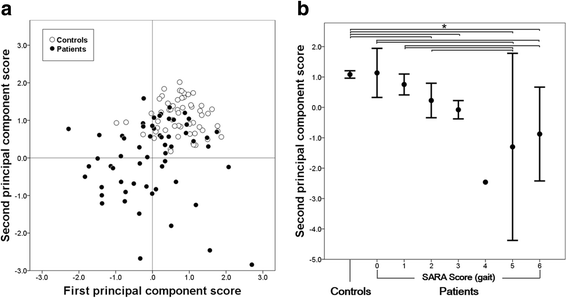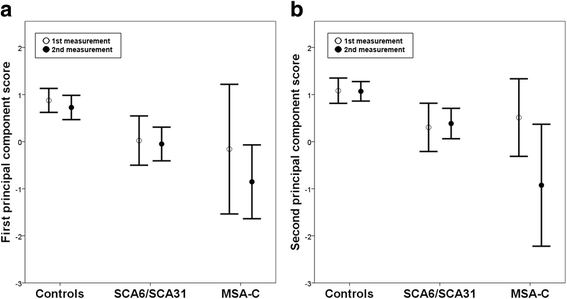Principal component analysis for ataxic gait using a triaxial accelerometer
- PMID: 28464831
- PMCID: PMC5414235
- DOI: 10.1186/s12984-017-0249-7
Principal component analysis for ataxic gait using a triaxial accelerometer
Abstract
Background: It is quite difficult to evaluate ataxic gait quantitatively in clinical practice. The aim of this study was to analyze the characteristics of ataxic gait using a triaxial accelerometer and to develop a novel biomarker of integrated gate parameters for ataxic gait.
Methods: Sixty-one patients with spinocerebellar ataxia (SCA) or multiple system atrophy with predominant cerebellar ataxia (MSA-C) and 57 healthy control subjects were enrolled. The subjects were instructed to walk 10 m for a total of 12 times on a flat floor at their usual walking speed with a triaxial accelerometer attached to their back. Gait velocity, cadence, step length, step regularity, step symmetry, and degree of body sway were evaluated. Principal component analysis (PCA) was used to analyze the multivariate gait parameters. The Scale for the Assessment and Rating of Ataxia (SARA) was evaluated on the same day of the 10-m walk trial.
Results: PCA divided the gait parameters into four principal components in the controls and into two principal components in the patients. The four principal components in the controls were similar to those found in earlier studies. The second principal component in the patients had relevant factor loading values for gait velocity, step length, regularity, and symmetry in addition to the degree of body sway in the medio-lateral direction. The second principal component score (PCS) in the patients was significantly correlated with disease duration and the SARA score of gait (ρ = -0.363, p = 0.004; ρ = -0.574, p < 0.001, respectively).
Conclusions: PCA revealed the main component of ataxic gait. The PCS of the main component was significantly different between the patients and controls, and it was well correlated with disease duration and the SARA score of gait in the patients. We propose that this score provides a novel method to assess the severity of ataxic gait quantitatively using a triaxial accelerometer.
Keywords: Ataxic gait; Cerebellar ataxia; Gait analysis; Principal component analysis; SARA; Triaxial accelerometer.
Figures


Similar articles
-
Clinical assessment of standing and gait in ataxic patients using a triaxial accelerometer.Cerebellum Ataxias. 2015 Aug 6;2:9. doi: 10.1186/s40673-015-0028-9. eCollection 2015. Cerebellum Ataxias. 2015. PMID: 26331052 Free PMC article.
-
The Responsiveness of Triaxial Accelerometer Measurement of Gait Ataxia Is Higher than That of the Scale for the Assessment and Rating of Ataxia in the Early Stages of Spinocerebellar Degeneration.Cerebellum. 2019 Aug;18(4):721-730. doi: 10.1007/s12311-019-01025-5. Cerebellum. 2019. PMID: 30993540
-
Quantitative evaluation of gait ataxia by accelerometers.J Neurol Sci. 2015 Nov 15;358(1-2):253-8. doi: 10.1016/j.jns.2015.09.004. Epub 2015 Sep 3. J Neurol Sci. 2015. PMID: 26362336
-
[Cerebellar ataxic gait].Brain Nerve. 2010 Nov;62(11):1203-10. Brain Nerve. 2010. PMID: 21068457 Review. Japanese.
-
Monitoring disease progression in spinocerebellar ataxias: implications for treatment and clinical research.Expert Rev Neurother. 2017 Sep;17(9):919-931. doi: 10.1080/14737175.2017.1364628. Epub 2017 Aug 13. Expert Rev Neurother. 2017. PMID: 28805093 Review.
Cited by
-
Local Dynamic Stability of Trunk During Gait is Responsive to Rehabilitation in Subjects with Primary Degenerative Cerebellar Ataxia.Cerebellum. 2024 Aug;23(4):1478-1489. doi: 10.1007/s12311-024-01663-4. Epub 2024 Jan 27. Cerebellum. 2024. PMID: 38279000 Free PMC article.
-
Dimensionality Reduction of Human Gait for Prosthetic Control.Front Bioeng Biotechnol. 2021 Oct 14;9:724626. doi: 10.3389/fbioe.2021.724626. eCollection 2021. Front Bioeng Biotechnol. 2021. PMID: 34722477 Free PMC article.
-
Classification of Ataxic Gait.Sensors (Basel). 2021 Aug 19;21(16):5576. doi: 10.3390/s21165576. Sensors (Basel). 2021. PMID: 34451018 Free PMC article.
-
Quantification of Upper Limb Movements in Patients with Hereditary or Idiopathic Ataxia.Cerebellum. 2023 Dec;22(6):1182-1191. doi: 10.1007/s12311-022-01485-2. Epub 2022 Oct 21. Cerebellum. 2023. PMID: 36269527 Free PMC article.
-
Effects of gait support in patients with spinocerebellar degeneration by a wearable robot based on synchronization control.J Neuroeng Rehabil. 2018 Sep 19;15(1):84. doi: 10.1186/s12984-018-0425-4. J Neuroeng Rehabil. 2018. PMID: 30231916 Free PMC article.
References
MeSH terms
LinkOut - more resources
Full Text Sources
Other Literature Sources
Medical

